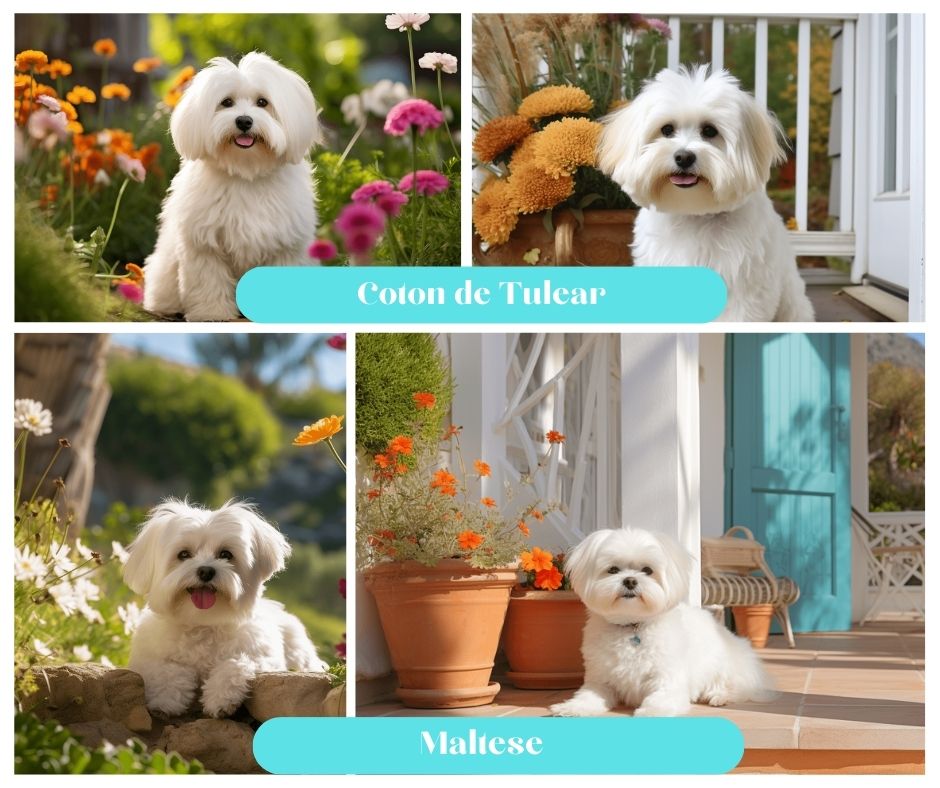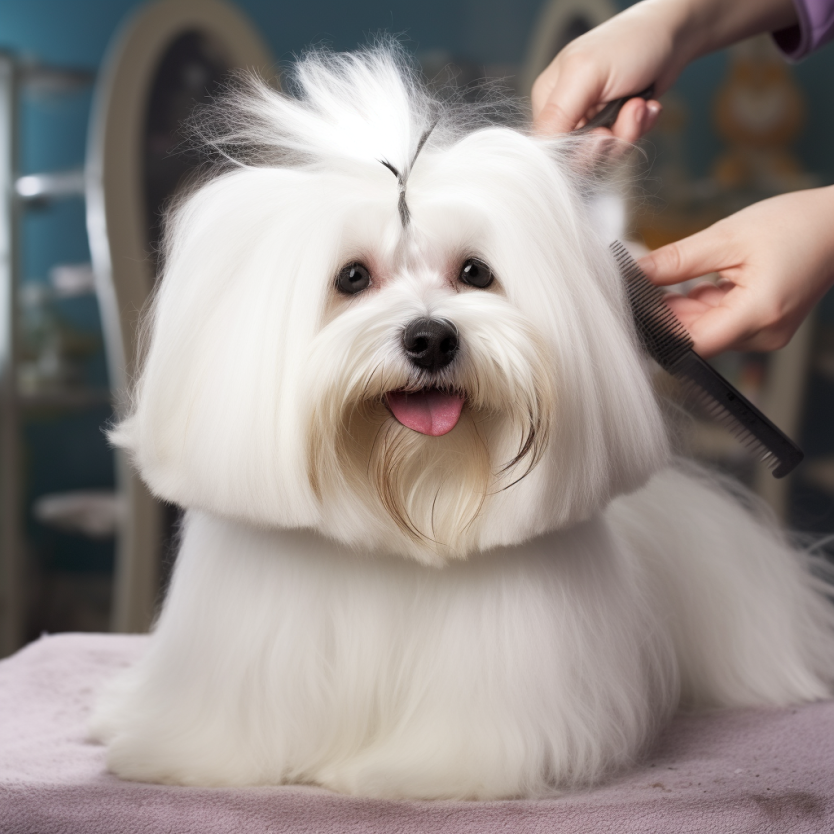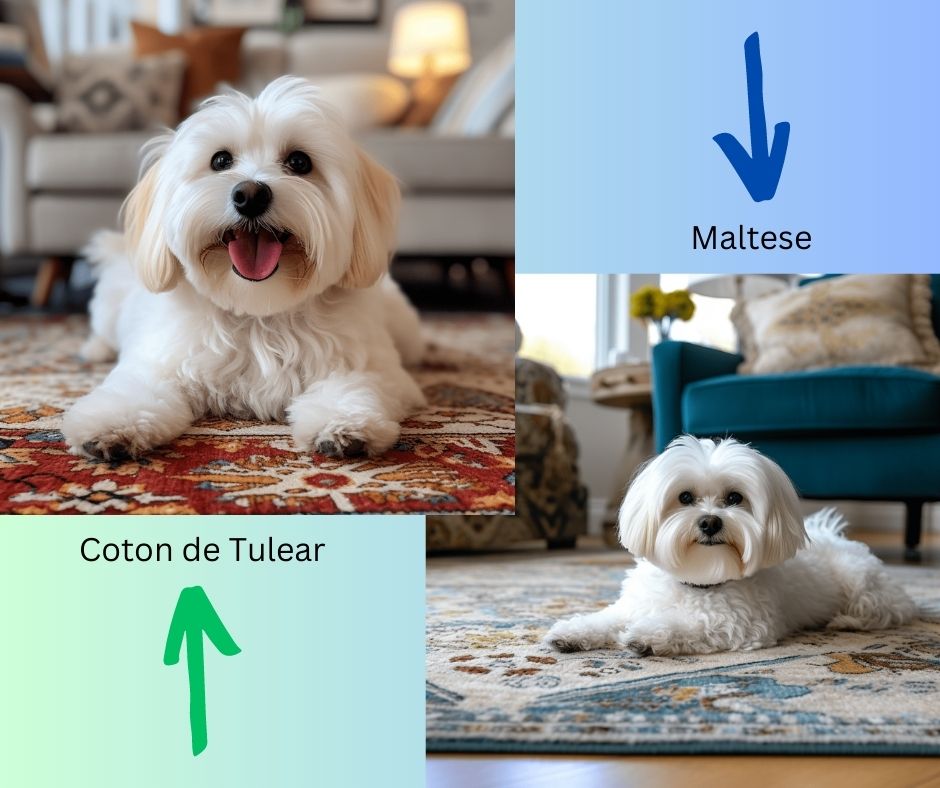Coton de Tulear vs Maltese: Can you tell them apart?
Coton de Tulear vs Maltese: Are all small white dogs the same?
So many visitors to our Coton de Tulear Care website send in photos of their cute white dogs and ask, “Is my dog a Coton?” It’s not as easy to answer as you think from a photo for several reasons.
First, depending on where Cotons originate can determine how much of a resemblance there is to the Maltese. European Cotons are smaller than Malagasy Cotons and have features more like the Maltese.
The Malagasy Cotons are larger and have adorable big black noses so it’s usually easier to tell them apart from other small dog breeds like the Maltese. Also, many groomers give all small breeds the same haircut, which makes it harder to tell them apart.
The Maltese are a more popular breed simply because they are more readily available and more widely known. When people ask me what kind of dog I have, I cringe when I tell them because I usually get a vacant “huh?” Even now, many people just aren’t familiar with the Coton de Tulear.
But in this post, you’ll learn how to tell the difference between the Maltese and Coton de Tulear breeds.
Coton de Tulear vs Maltese Dogs
It’s easy to spot the differences once you know what to look for.
Origin Story: Coton de Tulear vs Maltese
Coton de Tulear:
The Coton de Tulear, fondly referred to as "Cotons,” originally hail from the island of Madagascar. The exact origin of the dog depends on who is telling the story. They're renowned for their fluffy, cotton-like coats—hence the name, lively personalities, and pleasant demeanors.
Maltese:
On the other hand, Maltese are Mediterranean, with roots dating back thousands of years. With silky coats and an affectionate disposition, these lap dogs have been melting hearts for generations.
According to the American Coton Club and the American Kennel Club, both breeds are part of the Bichon family, and includes the Maltese, Coton de Tulear, Bichon Frise, Bolognese, Havanese, and the Lowchien. Both breeds are also considered hypoallergenic and are often good for allergy sufferers due to their non-shedding (or low-shedding) coats.
Coton de Tulear vs Maltese: Defining Details

Appearance
When it comes to physical characteristics, both the Coton De Tulear and Maltese are small dogs known for their adorable looks. However, there are some differences in their appearance that make them unique.
Cotons: Sporting a dense coat that's as fluffy as cotton candy, they come mostly in shades of white. But they also can be black and white or tri-colored. Their cotton-like coat is their claim to fame. Cotons de Tulear are generally larger than Maltese, with an average weight between 8 and 15 pounds. (But I always seem to attract the over 20 pounders - Both Luc and Lucy are bigger than average).
Maltese: With a flowing, silky white coat, these little guys seem to have stepped straight out of a doggie shampoo commercial! They are always white, but can have lemon or tan colors on their ears. They are also smaller than the Coton and considered a toy dog breed, averaging between 7 and 9 pounds. There’s also a teacup size, averaging 4-5 pounds.
Personality and Temperament
Both breeds are considered an excellent choice for those seeking companion dogs, as they are affectionate dogs who develop strong bonds with their humans.
Cotons: The Coton de Tulear breed is known for its affectionate and people-pleasing nature. They are intelligent and can suffer from separation anxiety. Cotons are also incredibly charismatic and have clown-like personalities. They are gentle, loyal, and sociable dogs who love to be around their people.
However, they can be cautious among unfamiliar faces. Cotons are adaptable and can adjust their energy levels and daily schedules to suit your pace. They thrive on their human's attention yet can entertain themselves when necessary.
Maltese: Gentle, loving, and often a bit on the reserved side, Maltese make wonderful companions for those seeking calm and comfort. Like Cotons, they are affectionate, people-pleasers, and somewhat clingy.
Like the Coton, Maltese dogs can suffer from separation anxiety. They are also great with older children and other pets. They are adaptable and can adjust to any lifestyle.
Grooming Needs

Cotons:
The Coton De Tulear grooming requirements depend on the age of your dog and the length of their coat. At 6-14 months, they “blow their coats,” and it becomes necessary to brush them frequently to prevent mats. And even with daily brushing, those tangles seem to pop up out of thin air. Thankfully, this stage doesn’t last too long.
If you keep your dog in a longer coat, daily brushing will be a must! Many Coton parents keep their dogs in a puppy cut, so they only need to brush their coat about once a week and trim it every four to six weeks.
Lifestyle plays a large part in what length you keep your dog’s coat. Lucy HATES being brushed, so keeping her in a shorter haircut is easier on both of us.
Since Cotons have long floppy ears, they are prone to ear infections, so you should clean their ears regularly. You should also trim their nails routinely to prevent them from becoming too long and causing discomfort.
Maltese:
With their flowing hair, Maltese are considered high-maintenance dogs that require regular grooming. They have long, silky hair that requires daily brushing to prevent matting and tangling. You should also trim their hair every four to six weeks to keep it from becoming too long.
The best way to prevent ear infections is to keep their ears clean. They are also prone to dental problems, so you should brush their teeth regularly and take them to the vet for regular dental cleanings.
Grooming is an important factor to consider when it comes to the Coton de Tulear vs Maltese. It can take a lot of time and money to look so cute and beautiful!
Common Health Issues
Cotons:
The Coton De Tulear is a generally healthy breed with a lifespan of 14-16 years. However, like all breeds, they are prone to certain health issues. Some of the common health issues that the Coton De Tulear may face include:
- Patellar Luxation: A condition in which the kneecap dislocates from its normal position.
- Progressive Retinal Atrophy (PRA): A genetic disease that causes gradual vision loss and can lead to blindness.
- Hip Dysplasia: A condition in which the hip joint doesn't develop properly, causing pain and discomfort.
- Ear infections: Allergies, moisture, hormonal imbalances, and foreign bodies can cause frequent ear issues.
- Dental issues: As with any breed, dental care is important to prevent problems with their teeth.
Maltese:
Maltese are a generally healthy breed with a lifespan of 12-15 years. However, like all breeds, they are prone to certain health issues. Some of the common health issues that Maltese may face include:
- Dental problems: Maltese are prone to dental issues, including tooth decay and gum disease.
- Head shaking: Can be caused by issues such as allergies, ear infections, ear mites, foreign objects, or even behavioral causes.
- Tracheal collapse: It is a condition in which the trachea, or windpipe, collapses, causing coughing and difficulty breathing.
- Liver shunt: A condition where blood flow bypasses the liver, affecting its ability to detoxify and filter the blood properly.
To minimize the heartbreak of having a sick dog, obtaining your dog through a reputable breeder is critical. Good breeders will do extensive genetic testing to ensure that the health and temperament of the dog is preserved.
Both breeds have several breed clubs designed to promote responsible breeding practices, ensure the health and welfare of the dogs, maintain breed standards, and protect the interests of both the breed and the breeders.
DNA testing for health concerns can also help your veterinarian diagnose and treat your dog. You can learn more how these tests can help here.
Trainability
Cotons:
These smarty-pants are highly trainable, thanks to their eagerness to please and learn. Both of my Cotons outsmarted me at times. So sneaky! But remember, they respond best with positive reinforcement methods.
While Cotons are known for their social nature, they can be stubborn at times, so consistent training and patience are necessary.
Maltese:
The Maltese are also a highly trainable breed eager to please their owners, but they can be difficult to housebreak.
For some reason, the Maltese doesn’t make it to the list of the most intelligent dog breeds. Maybe it’s because they tend to be a bit stubborn. Patience, consistency, and a lot of treats are the order of the day!
As with any breed, every dog is different. Within each breed, you can find dogs who learn quickly and those that are more stubborn and require more patience and practice.
Energy and Exercise Requirements
Cotons:
These little energy bombs need a good amount of playtime, whether it's a game of fetch or a brisk walk. It’s not uncommon for Cotons to get the Zoomies when they don’t get enough exercise. So cute! Energy levels can vary from one Coton to another - some have adventurous spirits, and some are happy being couch potatoes. Cotons are adaptable dogs who usually fit in with their human’s lifestyle.
The Coton De Tulear requires daily exercise and mental stimulation to keep them healthy and happy. They also excel in agility and obedience competitions. Early socialization is essential to prevent any shyness or fearfulness toward strangers or other dogs.
Maltese:
Maltese are not usually as high-energy as Cotons, but they do require daily exercise, mental stimulation, and socialization to keep them healthy and happy. Like the Coton, they are also perfectly content to snooze on your lap.
Like the Coton, Maltese also excel in agility and obedience competitions. Consistent training and patience are necessary to prevent behavioral issues, such as excessive barking or aggression toward strangers or other dogs.
Coton de Tulear vs Maltese FAQs
Are Coton de Tulear and Maltese good with kids?
Yes, both breeds are known to be good with children. They are both considered good family dogs who love spending time with their humans. But with the Maltese, younger children may not be suitable or may need to be supervised since they tend to be too rough with the tiny pups.
Are Cotons and Maltese hypoallergenic?
While there’s no such thing as a truly hypoallergenic dog, both breeds are often described as hypoallergenic since they are low shedding, low dander-producing dogs. This makes them a good choice for people with allergies. However, since individual reactions vary, it’s always important to spend time with the puppy before bringing it home.
Which breed is easier to train, Coton de Tulear or Maltese?
While individual dog intelligence and temperament may vary, Cotons are generally considered easier to train due to their intelligence and eager-to-please nature. But these are only generalizations. Many visitors to this website say the Coton is easy to train, while others say it’s difficult.
Do Maltese and Coton de Tulear dogs bark a lot?
Both breeds can be a bit yappy, especially if left alone for long periods. Providing ample physical and mental stimulation can help curb this behavior. My Coton, Luc, was a barker. But Lucy hardly ever barks. My guess is that Lucy was better socialized from an early age with the breeder.
Do these breeds make good apartment dogs?
Yes, small dogs like Cotons and Maltese are suitable for apartment living due to their small size and moderate exercise needs.
Which breed has a longer life expectancy, Coton de Tulear or Maltese?
Both breeds have relatively long lifespans, with Cotons living between 14-16 years and Maltese living between 12-15 years on average.
Which breed is more expensive?
When obtaining a puppy from reputable breeders, the price of a Coton is usually higher on average, largely because they are a more rare breed.
Is separation anxiety common in the Coton or the Maltese breed?
Both breeds can experience separation anxiety, so it’s important to socialize them as early as possible. Neither breed does well with being left alone for long periods of time.
So, if you work outside the home, planning for help, such as dog walkers, pet sitters, or doggy daycare while you’re gone, is important.
How can I tell if my dog is a Coton de Tulear vs Maltese - or something else?
The most effective way is to do a DNA test. You can learn more about that here.
And the Winner Is...
Just kidding! There are no losers when you find the best dog for you and your family. When it comes to the Coton de Tulear vs Maltese showdown, it's safe to say that there's no one-size-fits-all answer.
Of course, I’m a bit biased toward the Coton de Tulear since I’ve had the pleasure of living with two of these amazing dogs. But ultimately, the choice boils down to your personal preference, lifestyle, and what you're looking for in a dog.
Whether it's the vivacious Coton or the calm and gentle Maltese, both breeds make wonderful companions, spreading nothing but love, joy, and a whole lot of fluff!
Home | About Me | Contact Me | Privacy Policy |Disclosure
Copyright© 2008- All Rights Reserved










